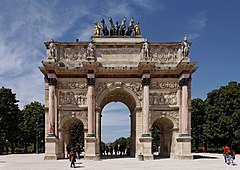Arc de Triomphe du Carrousel
| Arc de Triomphe du Carrousel | |
|---|---|

The Arc de Triomphe du Carrousel
|
|
| General information | |
| Type | Triumphal arch |
| Location | Paris, France |
| Construction started | 1806 |
| Completed | 1808 |
| Design and construction | |
| Architect | Charles Percier, Pierre François Léonard Fontaine |
The Arc de Triomphe du Carrousel (pronounced: [aʁk də tʁijɔ̃f dy kaʁusɛl]) is a triumphal arch in Paris, located in the Place du Carrousel. It was built between 1806 and 1808 to commemorate Napoleon's military victories of the previous year. The more famous Arc de Triomphe de l'Étoile, across from the Champs Élysées, was designed in the same year; it is about twice the size and was not completed until 1836. It is also an example of Corinthian style architecture.
The monument is 63 feet (19 m) high, 75 feet (23 m) wide, and 24 feet (7.3 m) deep. The 21 feet (6.4 m) high central arch is flanked by two smaller ones, 14 feet (4.3 m) high, and 9 feet (2.7 m) wide. Around its exterior are eight Corinthian columns of marble, topped by eight soldiers of the Empire. On the pediment, between the soldiers, bas-reliefs depict:
Napoleon's diplomatic and military victories are commemorated by bas-reliefs executed in rose marble. They depict:
The arch is, of course, derivative of the triumphal arches of the Roman Empire; in particular that of Septimius Severus in Rome. The subjects of the bas-reliefs devoted to the battles were selected by the director of the Napoleon Museum (Paris) (located at the time in the Louvre), Vivant Denon, and designed by Charles Meynier.
The upper frieze on the on entablement has sculptures of soldiers: Auguste Marie Taunay's cuirassier (left), Charles-Louis Corbet's dragoon, Joseph Chinard's horse grenadier and Jacques-Edme Dumont's sapper.
...
Wikipedia
